

Photo Essay
Photo essay generator.
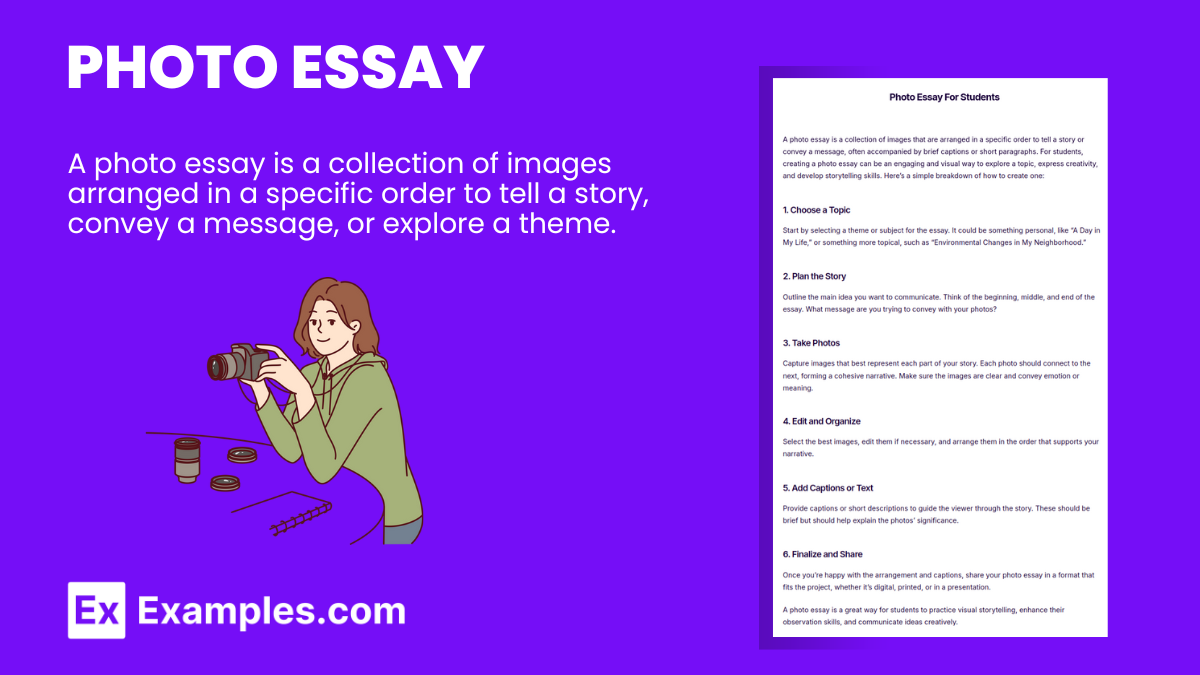
We all know that photographs tell a story. These still images may be seen from various perspectives and are interpreted in different ways. Oftentimes, photographers like to give dramatic meaning to various scenarios. For instance, a blooming flower signifies a new life. Photographs always hold a deeper meaning than what they actually are.
In essay writing , photographs along with its supporting texts, play a significant role in conveying a message. Here are some examples of these kinds of photo-text combinations.
What is Photo Essay?
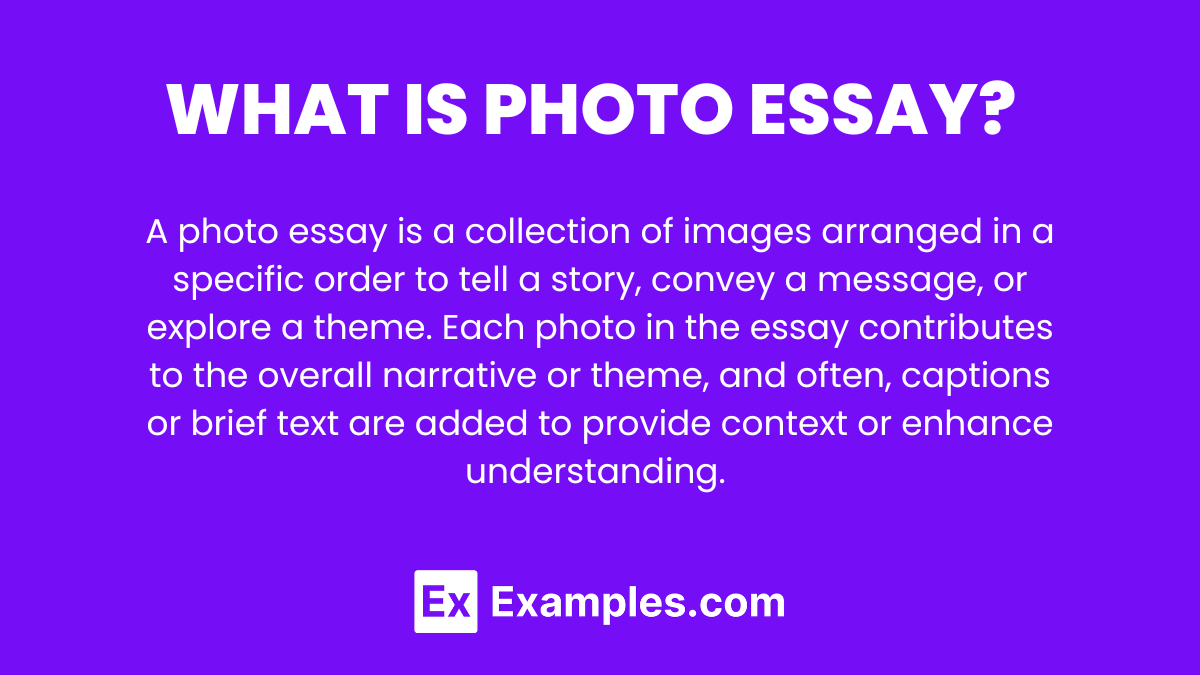
Download Photo Essay Bundle
Photo Essay Format
A photo essay is a series of photographs that are intended to tell a story or evoke a series of emotions in the viewer. It is a powerful way to convey messages without the need for many words. Here is a format to guide you in creating an effective photo essay:
Choose a Compelling Topic
Select a subject that you are passionate about or that you find intriguing. Ensure the topic has a clear narrative that can be expressed visually.
Plan Your Shots
Outline the story you wish to tell. This could involve a beginning, middle, and end or a thematic approach. Decide on the types of shots you need (e.g., wide shots, close-ups, portraits, action shots) to best tell the story.
Take Your Photographs
Capture a variety of images to have a wide selection when editing your essay. Focus on images that convey emotion, tell a story, or highlight your theme.
Edit Your Photos
Select the strongest images that best convey your message or story. Edit for consistency in style, color, and lighting to ensure the essay flows smoothly.
Arrange Your Photos
Order your images in a way that makes sense narratively or thematically. Consider transitions between photos to ensure they lead the viewer naturally through the story.
Include Captions or Text (Optional)
Write captions to provide context, add depth, or explain the significance of each photo. Keep text concise and impactful, letting the images remain the focus.
Present Your Photo Essay
Choose a platform for presentation, whether online, in a gallery, or as a printed booklet. Consider the layout and design, ensuring that it complements and enhances the visual narrative.
Conclude with Impact
End with a strong image or a conclusion that encapsulates the essence of your essay. Leave the viewer with something to ponder , reflecting on the message or emotions you aimed to convey.
Best Photo Essay Example
One notable example of a powerful photo essay is “The Photographic Essay: Paul Fusco’s ‘RFK Funeral Train'” by Paul Fusco. This photo essay captures the emotional journey of the train carrying the body of Robert F. Kennedy from New York to Washington, D.C., after his assassination in 1968. Fusco’s images beautifully and poignantly document the mourning and respect shown by people along the train route. The series is a moving portrayal of grief, unity, and the impact of a historical moment on the lives of ordinary individuals. The photographs are both artistically compelling and deeply human, making it a notable example of the potential for photo essays to convey complex emotions and historical narratives.
Short Photo Essay Example
The day begins quietly, marked by the soft beeping of an alarm clock at 6:00 AM. The dim glow from the screen cuts through the darkness, signaling the start of a new morning. As the alarm fades, a person stretches lazily in bed, basking in the gentle rays of sunlight streaming through the window. The morning light, still soft and golden, fills the room with a sense of calm, signaling the peaceful transition from sleep to wakefulness. Moving into the kitchen, the comforting scent of freshly brewed coffee fills the air. A steaming cup sits on the counter, the warmth rising with every breath of steam. It’s a moment of quiet reflection before the busyness of the day begins. The coffee, simple yet essential, provides a moment of pause, a brief chance to savor the stillness of the morning. Finally, the morning routine wraps up with a quiet sense of readiness. The day ahead is yet to unfold, but these small, simple moments — waking up, stretching, and enjoying a cup of coffee — set the tone for what’s to come, illustrating the peaceful rhythm of a new day.
Photo Essay For Students
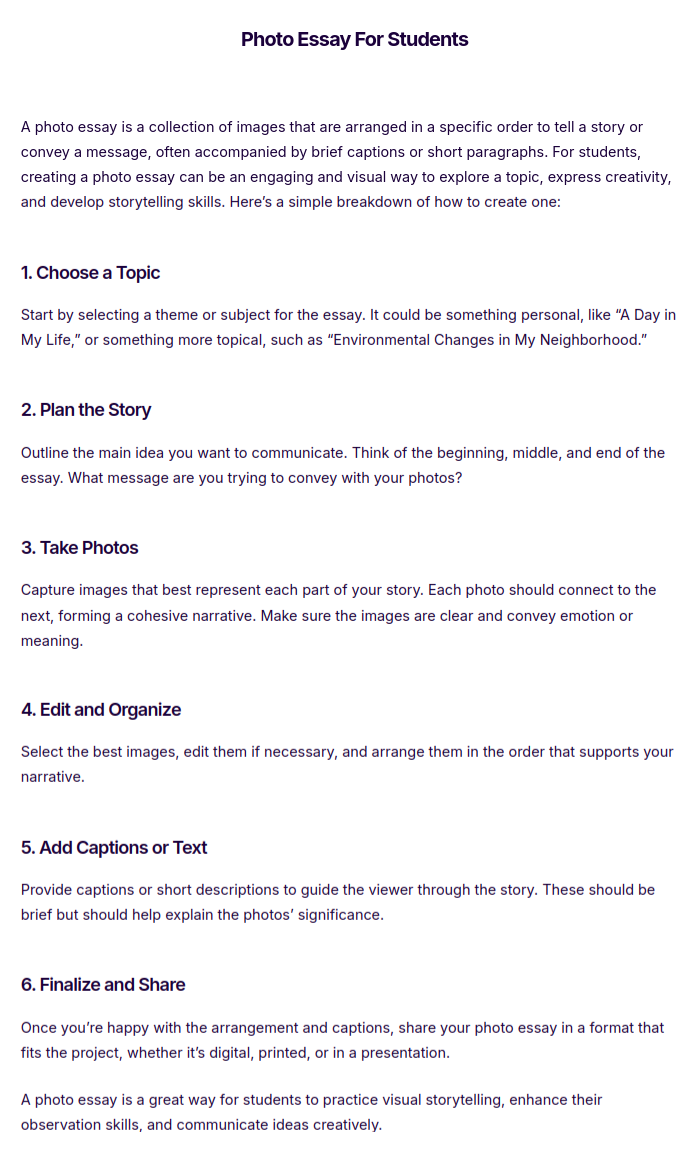
Photo Essay on Nature
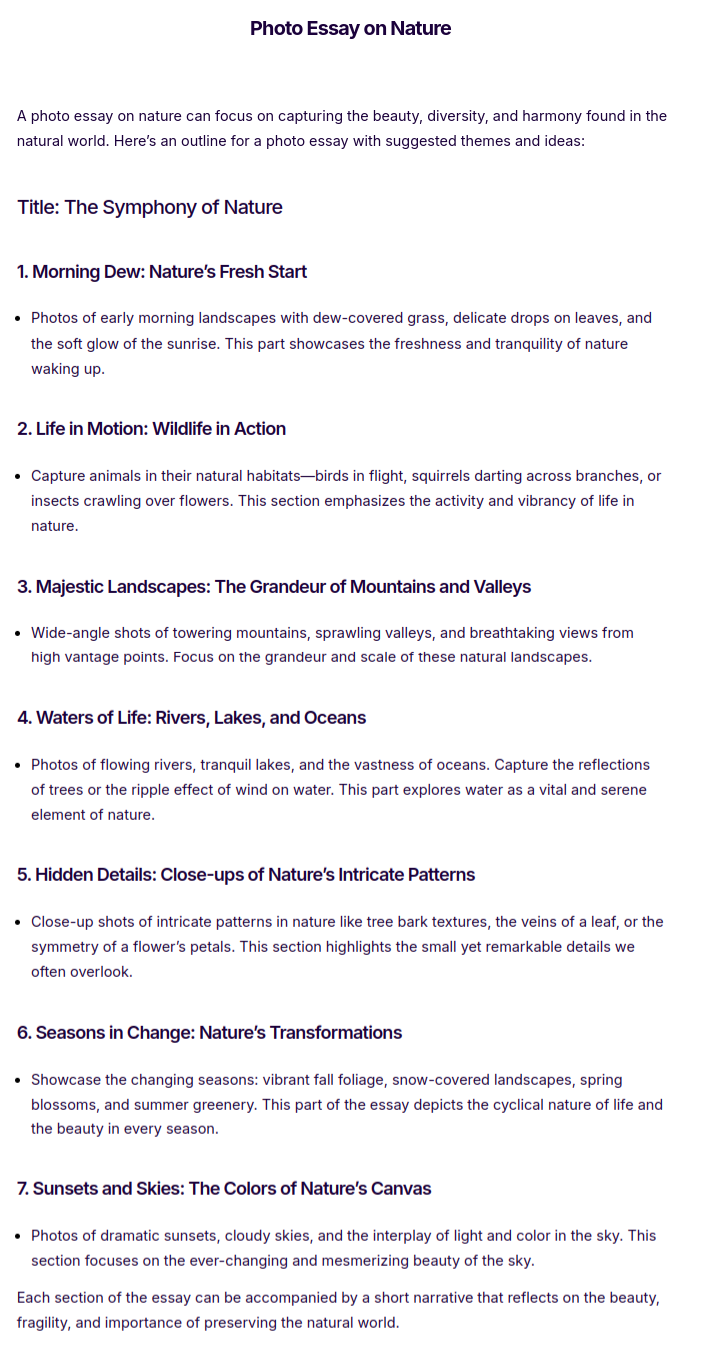
Photo Essay For Kids

Photo Essay Examples & Templates
1. narrative photo essay format example.
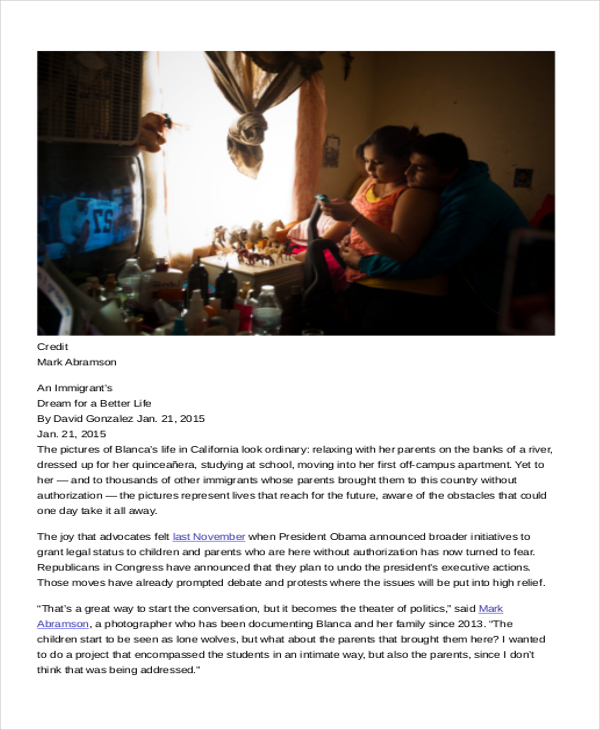
nytimes.com
2. Example of Photo Essay
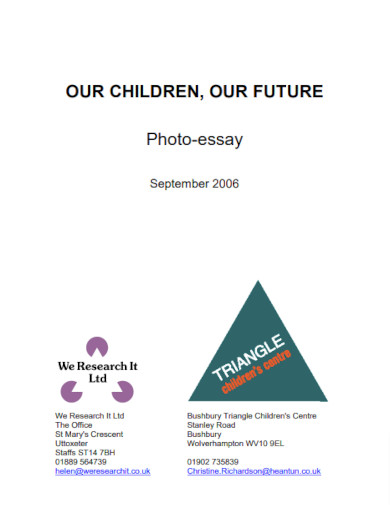
weresearchit.co.uk
3. Travel Photo Essay Example

theguardian.com
4. Free Photo Essay Example

vasantvalley.org
5. Photo Essay in PDF
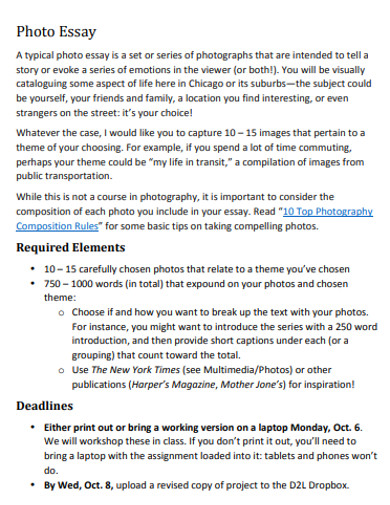
condor.depaul.edu
6. Sample Photo Essay Example
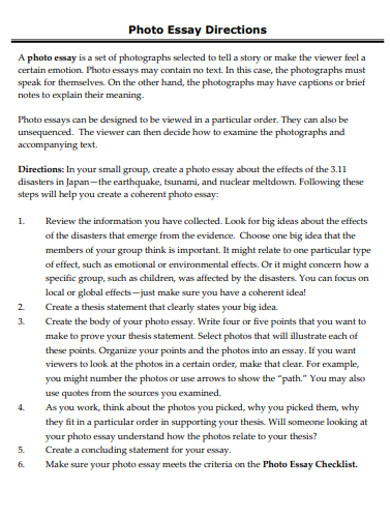
colorado.edu
How to Write Photo Essay?
Writing a photo essay involves using a series of images to tell a cohesive story or convey a message, often supported by brief captions or accompanying text. Here’s a step-by-step guide on how to write a successful photo essay:
Choose a Theme or Topic
Start by selecting a clear subject for your photo essay. It could be an event, a social issue, a personal story, or a particular theme (e.g., urban life, nature, emotions). Make sure it’s a topic you’re passionate about or that resonates with you, as this will influence the depth of your storytelling.
Plan the Structure
Like any narrative, your photo essay should have a beginning, middle, and end. Outline how you want to introduce the story, what key points you want to highlight in the middle, and how you will conclude it. Ensure that the flow between images feels natural and cohesive.
Take or Select Your Photos
Gather images that visually represent your story. If you’re taking the photos, consider the composition, lighting, and emotional impact of each shot. Aim for a variety of perspectives (e.g., wide shots, close-ups) to add depth to your essay.
Write Captions or Accompanying Text
For each photo, write short captions that describe what is happening or enhance the story. The captions can provide context, highlight details, or convey emotions that the photos alone may not express. Keep the text concise and focused.
Edit and Organize the Photos
Review your photos and select the strongest ones that best represent your story. Arrange them in a sequence that flows logically. Each photo should contribute something meaningful to the essay — avoid redundancy or unnecessary shots.
Add a Title and Introduction
Give your photo essay a compelling title that reflects the essence of the story. In the introduction, provide a brief overview of the topic and why it matters, setting the stage for the audience to engage with the photos.
End your essay with a final photo that wraps up the story and reinforces your message. You can add a concluding sentence or paragraph to summarize the theme or leave the viewer with something to reflect on.
Review and Refine
Review the entire essay, ensuring the images and text work together cohesively. Fine-tune the captions, check the order of the photos, and make sure your story flows smoothly from start to finish.

Types of Photo Essay
There are several types of photo essays, each serving a different purpose and employing unique approaches to visual storytelling. Here are some common types:
1. Narrative Photo Essay
- Definition : This type of photo essay tells a story through a sequence of images, similar to a written narrative. The story unfolds over the course of the essay, often with a clear beginning, middle, and end.
- Example : A photo essay documenting a wedding day, from the preparations to the ceremony and reception.
2. Thematic Photo Essay
- Definition : A thematic photo essay focuses on a specific subject, concept, or idea. The photos revolve around the theme, but there’s no strict narrative progression.
- Example : A series of photos capturing different aspects of urban street life, exploring themes like isolation, community, or movement.
3. Documentary Photo Essay
- Definition : This type of essay documents real-life events, people, or places, often in a journalistic or social context. It aims to inform or raise awareness about a particular issue.
- Example : A photo essay covering the effects of climate change on a specific region or community.
4. Portrait Photo Essay
- Definition : A portrait photo essay focuses on a single subject or a group of people, using close-up images to capture expressions, emotions, or personality traits. The essay can explore the subject’s story or identity.
- Example : A series of photos documenting the life of an artist, showing them at work, with their creations, and in their personal space.
5. Event-Based Photo Essay
- Definition : This type of essay documents a specific event, often in real-time, with a series of photos capturing different moments of the event.
- Example : A photo essay of a music festival or a political protest, capturing key moments and the atmosphere.
6. Process Photo Essay
- Definition : A process photo essay shows the step-by-step progression of an activity or event, focusing on how something is done from start to finish.
- Example : A photo essay documenting the process of making traditional pottery, from gathering clay to the final glazed product.
7. Personal Photo Essay
- Definition : A personal photo essay is introspective and often documents the photographer’s own life, thoughts, or experiences. It tends to be more intimate and reflective.
- Example : A self-portrait series capturing personal growth over time, or a travel photo essay of the photographer’s journey through a country.
8. Comparative Photo Essay
- Definition : A comparative photo essay juxtaposes two or more subjects, places, or ideas to highlight contrasts or similarities. It can draw attention to changes over time or differences between cultures.
- Example : A photo essay comparing urban life in two different cities, showcasing differences in architecture, street life, and public spaces.
Each type of photo essay provides a unique way of storytelling, allowing photographers to communicate a message, evoke emotions, or raise awareness about a specific topic or issue.
Importance of Photo Essay
The importance of a photo essay lies in its ability to communicate ideas, emotions, and stories through visual imagery in a compelling and impactful way. Here are some key reasons why photo essays are important:
1. Visual Storytelling
- Photo essays allow for powerful storytelling without relying on words. By using images to tell a story, photo essays engage viewers in a more immediate and emotional way, often conveying complex narratives or concepts that words alone might struggle to express.
2. Engaging and Accessible
- Images are universally understood, making photo essays more accessible to diverse audiences, including those who speak different languages or may have limited literacy. This makes them an excellent medium for broad communication, especially in journalism and social advocacy.
3. Eliciting Emotional Response
- Photos have the power to evoke strong emotional reactions. A well-curated photo essay can make viewers feel empathy, sadness, joy, or outrage, which can create a lasting impression and drive awareness about important issues.
4. Raising Awareness
- Photo essays are often used to highlight social, environmental, or political issues. Through documentary photography, they can bring attention to topics such as poverty, climate change, human rights, or cultural preservation, sparking conversation and inspiring action.
5. Preserving History
- Photo essays document events, people, and cultures, serving as a historical record. By capturing important moments or changes in society, they preserve history for future generations and help people understand the past through a visual lens.
6. Creative Expression
- For photographers and artists, photo essays offer a medium for creative expression. They can explore personal stories, abstract concepts, or artistic themes, providing a platform to showcase their vision and creativity.
7. Enhancing Communication
- In journalism and media, photo essays help convey information quickly and effectively. In combination with text, they provide context and depth to stories, making them more impactful and easier to understand.
8. Influencing Change
- By illustrating real-life issues, photo essays have the power to influence public opinion and policy. Images from conflict zones, protests, or environmental disasters often spark global conversations and motivate people to advocate for change.
In essence, photo essays are important because they bridge the gap between art and communication, making complex subjects more understandable, engaging, and relatable to a wide range of audiences.
Tips for Photo Essay
Here are some tips for crafting a compelling photo essay:
- Choose a clear theme or story : Focus on a central idea or narrative that will guide your photo selection and create cohesion.
- Plan your shots : Think about the types of images you need to tell your story, including wide shots, close-ups, and detailed images.
- Show variety in composition : Use different angles, perspectives, and framing to keep the viewer engaged.
- Ensure emotional connection : Capture moments that evoke emotions and convey the essence of your subject matter.
- Edit carefully : Select only the best photos that contribute to the narrative, ensuring clarity and flow.
- Include captions : Add brief descriptions to provide context or additional insights for each image.
- Consider the sequence : Arrange your photos thoughtfully to create a logical or emotional progression throughout the essay.
1. How do I choose a theme for my photo essay?
Choose a theme that interests you or aligns with your goals. It could be based on social issues, personal experiences, travel, or everyday life. Ensure it has enough depth for visual exploration.
2. How many photos should a photo essay have?
There is no strict rule, but a typical photo essay includes 10–20 photos. Focus on quality and how well each image contributes to the overall story.
3. Do I need to include text in a photo essay?
Yes, captions or brief text can help provide context, explain the narrative, or offer background information. However, the images should carry most of the storytelling weight.
4. Can I use edited or manipulated photos in my essay?
Yes, but the level of editing depends on the purpose of the essay. For journalistic or documentary purposes, minimal editing is preferred to maintain authenticity. For artistic purposes, more creative manipulation might be appropriate.
5. What makes a strong photo essay?
A strong photo essay has a clear narrative, emotional depth, visually diverse images, and effective sequencing. Each image should add to the story, evoke a reaction, and work cohesively with the rest.
6. What are some common mistakes to avoid in a photo essay?
Avoid including too many images, losing focus on your central theme, or failing to create a cohesive story. Also, over-editing your photos can detract from the authenticity of the subject.
Text prompt
- Instructive
- Professional
Create a Photo Essay on the theme of urban exploration.
Discuss the story of a local community event through a Photo Essay.
- Share full article
Advertisement
Supported by
Picture Prompts
Over 140 Picture Prompts to Inspire Student Writing
By Natalie Proulx
- May 23, 2019
Sign up for our free Learning Network newsletter. Receive new writing prompts in your inbox every week.
Updated: May 31, 2019
Think The New York Times is only for readers at a high-school reading level? Think again.
Besides written articles, The Times also offers a rich collection of visuals — photos, illustrations, graphics, GIFs and short videos — that are accessible to learners of all levels. Since 2016, we’ve been featuring these images in our daily Picture Prompts : short, image-driven posts that invite a variety of kinds of student writing.
Teachers tell us they use these prompts in all kinds of ways. Some use them to encourage students to develop a daily writing habit . Others as an exercise to practice inferences , spark discussion or support reading . This year, one elementary school music teacher told us how her class used the visuals as inspiration for writing short stories accompanied by music .
For more ideas, we have a lesson plan on how to teach with Picture Prompts and other Times images, as well as a free, on-demand webinar that explores how to use our thousands of writing prompts for everyday low-stakes writing practice across the curriculum.
Below, we’ve categorized the 140+ prompts we published during the 2018-19 school year based on the type of writing they primarily ask students to do — whether it’s penning short stories and poems, sharing experiences from their own lives, telling us their opinions, or interpreting an image’s message. All are still open for comment.
You can find even more images in our Picture Prompt roundups for the 2016-17 and 2017-18 school years.
If you use this feature with your students, or if you have other ideas for how to use photos, illustrations and graphics to encourage writing, let us know in the comments section.
What story could this image tell? Use your imagination.
Three Dots Balloon Face Oars and S’mores Conversation Spaceship at the White House Around the Campfire Special Key Computer Screen 17-Foot Python Batman on a Couch Hanging With Friends Hole in the Ceiling In a Crowd Opossum Among Shoes Your Food Obsession Tech Gadgets Carrying a Letter Reaching Through the Wall Sledding in the Mountains Trees, River, Cottage and Sheep The Ride Headphones Leap In the Stands Shade Under the Table Security Line At Their Computers Tiny Stories Tarot Cards Haunted House? Driver and Bicyclist Red Ball Kneeling and Reaching A Letter in the Mail Campfire
Share experiences from your own life.
One Last Adventure Amusement Park Dog in a Backpack Generation Z Breakfast A New App Met Gala Tidying Up Take Your Child to Work Day New Homes Photos From Space Social Media Star Signs of Spring Literary Protagonists The Story of Your Name Dream Home Momo Gym Class Nostalgic Places Price Tags Night Owl or Early Bird Lunar New Year Rescue Pets Polar Vortex Facing Rejection Dreams Superstitions Holiday Season Astrology Favorite Books Journaling Caffeine Giving and Getting Candy Around the World Journeys Saying Thank You Nutrition ‘The Simpsons’ Man, Seal, Octopus Weddings The Night Sky Remembering 9/11 World’s Largest Prairie Dog
What do you think this image, chart or cartoon is saying?
Falling Bottles Focus Here Emojis Eagle and Gender Symbols Hand and Fist Jungle Gym Stacks of Money Magnifying Glass ‘Freedom From Want’ ‘The Writer’s Block’ Watching Walking Down the Street Gun Parts Globe and Books Head Full of Stuff Tight Rope Adventure New Faces Leaping Over Binoculars Brexit Floating Coins Giant Machine Blue Water Other People’s Burdens In a Maze Chalk Outline Hands on Their Shoulders Past and Future Pieces of a Flag From a Hole to a Balloon
What’s your opinion on this issue?
Spy Cams Jack-of-all-trades Gender Expectations Game Show Winner Royal Baby Movie Theaters Tiger Woods Wins ‘The Image of the Revolution’ Final Four Referees $430 Million Deal Student Climate Strikes Women’s History Month Legos and Battlebots Cash Reward Brushing Beagle Book Covers Super Bowl Commercials Math Fast-Food Buffet The ‘Bird Box’ Challenge Hands-On Parenting 2018 in Pictures The Outspoken N.B.A. Online Video Games Standout Steer California Wildfire Election Day Public Libraries Champions A Computer in Everything Snail Mail Fashion Trends Sleep Deprivation Household Chores Gymnastics on Horseback Song of Summer Giant Ice Disk
Want more writing prompts?
You can find our full collection of writing prompts, added as they publish, here . We also have a list of over 1,000 writing prompts for narrative and persuasive writing gathered from our daily Student Opinion questions . Plus, we have a collection of “ 40 Intriguing Images to Make Students Think ,” taken from four years of our weekly “ What’s Going On in This Picture? ” feature.

IMAGES
VIDEO